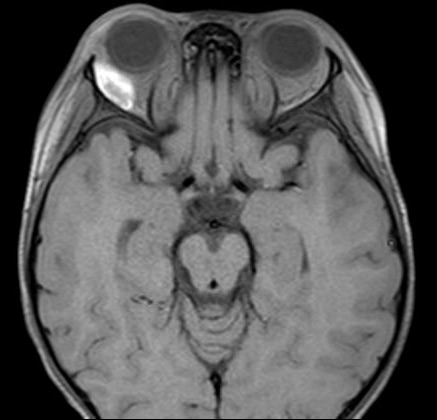Orbital hemorrhage secondary to ascorbic acid deficiency (scurvy) in a 5-year-old boy
Main Article Content
Abstract
A 5-year-old African American boy presented at Nicklaus Children’s Hospital, South Miami, with a 2-week history of right superior eyelid ecchymosis (A), slight proptosis of the right eye, gingival bleeding (B), and right-sided limp. His medical history was notable for autism. Laboratory work-up was initiated for neuroblastoma as well as leukemia and blood dycrasias. Magnetic resonance imaging of the brain and orbits revealed a 1.5 × 1.3 × 2.4 cm mass in the right superolateral extraconal space with mass effect upon the lateral rectus and superior muscle group. The mass demonstrated T1-weighted intermediate-to-high signal plus rim enhancement (C) and T2-weighted hyperintensity (D). The lesion abutted the right lacrimal gland, which was displaced anteriorly. Although less likely, the differential diagnosis of rhabdomyosarcoma and Langerhan’s histiocytosis were also entertained, and, given the suspicion for malignancy, a bone marrow biopsy was ordered, which revealed normal cellularity. The patient was scheduled to undergo an orbital biopsy, before which other causes of abnormal bleeding were explored. Vitamin C levels proved to be extremely low (0.13 mg/dl) indicating scurvy-associated findings, and the patient was supplemented with oral ascorbic acid 250 mg four times daily. With vitamin supplementation and nutritional rehabilitation his symptoms resolved over the subsequent weeks.
Downloads
Article Details

This work is licensed under a Creative Commons Attribution-NonCommercial-NoDerivatives 4.0 International License.
